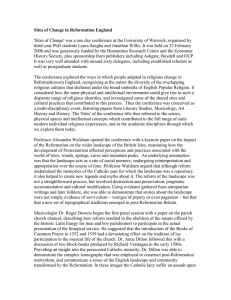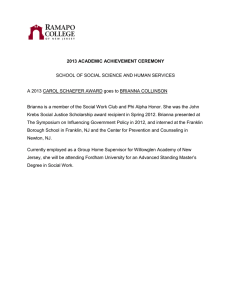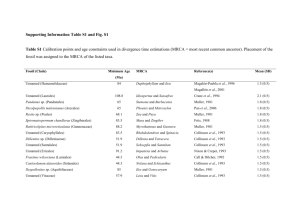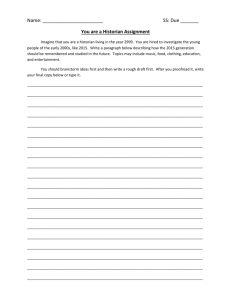The History of a History Man; Or, the
advertisement
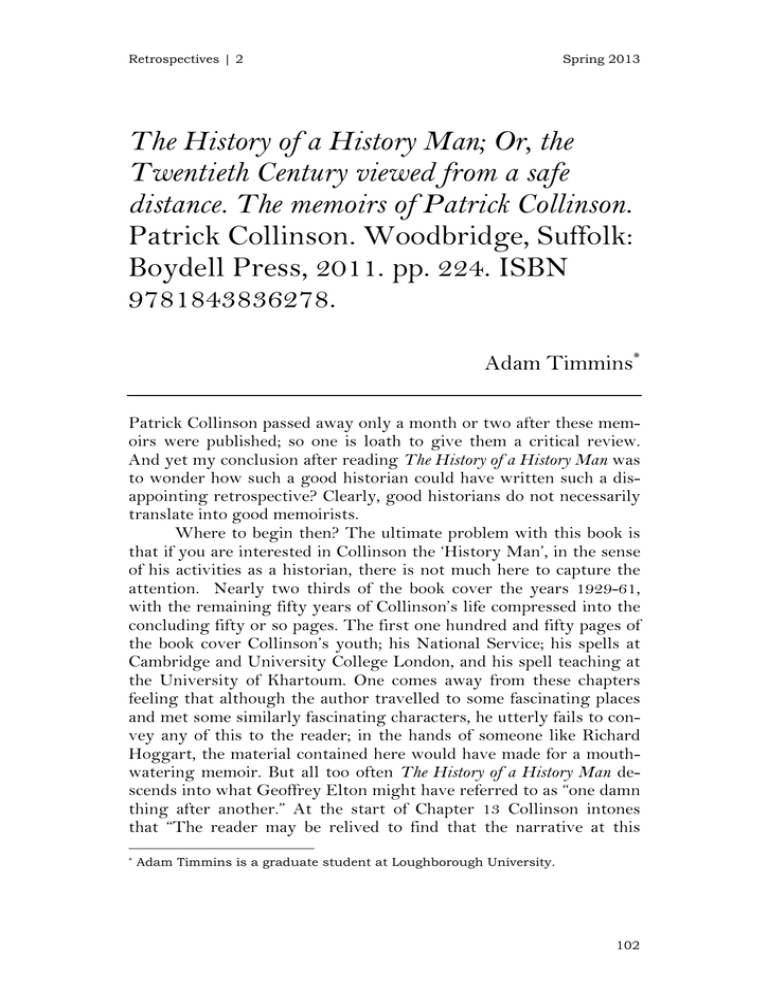
Retrospectives | 2 Spring 2013 ! The History of a History Man; Or, the Twentieth Century viewed from a safe distance. The memoirs of Patrick Collinson. Patrick Collinson. Woodbridge, Suffolk: Boydell Press, 2011. pp. 224. ISBN 9781843836278. Adam Timmins* Patrick Collinson passed away only a month or two after these memoirs were published; so one is loath to give them a critical review. And yet my conclusion after reading The History of a History Man was to wonder how such a good historian could have written such a disappointing retrospective? Clearly, good historians do not necessarily translate into good memoirists. Where to begin then? The ultimate problem with this book is that if you are interested in Collinson the ‘History Man’, in the sense of his activities as a historian, there is not much here to capture the attention. Nearly two thirds of the book cover the years 1929-61, with the remaining fifty years of Collinson’s life compressed into the concluding fifty or so pages. The first one hundred and fifty pages of the book cover Collinson’s youth; his National Service; his spells at Cambridge and University College London, and his spell teaching at the University of Khartoum. One comes away from these chapters feeling that although the author travelled to some fascinating places and met some similarly fascinating characters, he utterly fails to convey any of this to the reader; in the hands of someone like Richard Hoggart, the material contained here would have made for a mouthwatering memoir. But all too often The History of a History Man descends into what Geoffrey Elton might have referred to as “one damn thing after another.” At the start of Chapter 13 Collinson intones that “The reader may be relived to find that the narrative at this !!!!!!!!!!!!!!!!!!!!!!!!!!!!!!!!!!!!!!!!!!!!!!!!!!!!!!!! * Adam Timmins is a graduate student at Loughborough University. 102 Retrospectives | 2 Spring 2013 ! point ceases to be a travelogue.” (p. 139) This is a mild understatement, but alas it isn’t true - his account of his time at the University of Sydney is largely taken up with various trivia about living in Australia. The book might have benefiting from being re-titled; lest reader pick this tome up looking forward to reading an account of Collinson’s rise to Regius Professor: only to find a large number of anecdotes about the Cambridge rowing squad instead. Patrick Collinson graduated from Pembroke College, Cambridge with a First in 1951, and then went to study under J.E. Neale at University College London. The rancour which Neale inspired in some areas of the historical profession is legendary; and Collinson remarks that, “I can understand why Neale was so detested by many in the profession…But I can only say that he was good to me, and that I was quite fond of him.” (p. 79) After toying with the idea of ordination, Collinson returned to England, and with Neale’s help was appointed Assistant Lecturer in Ecclesiastical History at Kings College. His thesis was finally published in 1967 as The Elizabethan Puritan Movement, and was generally well received.1 He went to the University of Sydney in 1969, before returning to England to take up a post at the University of Kent in 1974.2 Even in this so-called ‘history’ section, history is mentioned sparingly: it might come as a surprise to the reader that after seemingly not doing much other than teach for the best part of his career Collinson was suddenly invited to give the Ford Lectures in 1979. In the 1980’s he moved to the University of Sheffield; the effect of Thatcher on the universities can surely be summed up by the fact that, as overseas students bought in much-needed money, “the university…bought a job lot of Syrians to read for an MA in Elizabethan and Jacobean Studies.” (p. 176) In 1984 he was invited to become Regius Professor of History at Cambridge, an event which, in the narrative of this book, seems to occur out of the blue. There are some amusing anecdotes from his time at Cambridge: for instance on finding a college willing to elect him to a professorial fellowship, and the general opinion that Elton’s !!!!!!!!!!!!!!!!!!!!!!!!!!!!!!!!!!!!!!!!!!!!!!!!!!!!!!!! 1 Although not by A.L. Rowse, who wrote in the English Historical Review that “It is well known that Mr Collinson has been engaged with this thoroughly rebarbative subject for some years, and we must all be grateful that he has finally got it off his chest.” (p 145). 2 Interestingly both Collision and Alastair Horne, in another recently published memoir, make the point that after returning from abroad in the 1970’S, England was a grim place to come back to under Heath. See Horne, But What Exactly Is It That You Do? A Literary Vagabondage, Weidenfield and Nicholson, 2011. 103 Retrospectives | 2 Spring 2013 ! Return to Essentials should not have been published. And his experiences with the Research Assessment Exercise (or Research Assessment Framework as it is now known), lead to comments which many will agree with. Whatever happened “to something called ‘scholarship?’…The RAE may have rekindled few spent volcanoes and have persuaded some drones to become bust bees. But at what a cost.” (p. 187) Collinson retired as Regius Professor in 1996; “Retirement for an academic historian is not to fall off a cliff but to descend quite a gentle glacis.” (p. 193) As stated earlier, Collinson was very good historian indeed. As John Morrill put it in his obituary, The Elizabethan Puritan Movement remains an essential book for anyone working in the field; and his essay on Elizabeth I for the Oxford Dictionary of National Biography was so good that it was issued as a paperback by OUP. Yet Collinson’s self-deprecation combined with his preference for writing about his travel experiences tends to obscure this. Ultimately one has to conclude that A History of a History Man is…well, fairly dull history – and that Collinson’s final book, to be posthumously published as Richard Bancroft and Anti-Puritanism, will serve as a much better epitaph. If you are interested in Collinson the man as opposed to Collinson the historian though, then this book will provide an interesting insight to his life. 104
